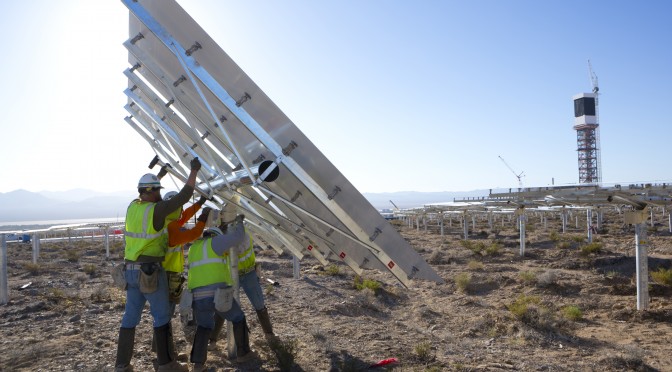Ivanpah, the world’s largest solar thermal project, reached the halfway mark of construction as well as the peak of its construction workforce at the end of July.
The project requires the work of skilled craft workers and engineers from a wide variety of trades and disciplines, including pipefitters, welders, millwrights, carpenters, electricians, laborers and civil engineers.
With more than 2,100 construction workers and project support staff on site, the project is on track to be completed in 2013. See below for construction updates from June and July, satellite images and a recap on Ivanpah Media Day and a special guest visit from President Bill Clinton.
Beginning in June 2012, we shared satellite images of Ivanpah that showed a new, unique view of the project. Just two months later, our new satellite images show measurable progress in the solar fields.
The August 2012 image reflects the Unit 1 solar field with over 90% of the total 53,500 heliostats installed. The remaining 10% will be installed upon the completion of the Unit 1 power block construction activity, which is expected at the end of 2012. Bechtel construction workers are installing heliostats in the northeast corner of the Unit 2 solar field, near Metamorphic Hill, and pylon installation is underway in the Unit 3 solar field.
In the Common Area, the Pad Bonding Buildings (PBBs) and the Heliostat Assembly Building (HAB) continue to operate above full production capacity, assembling more than 500 heliostats each day. Thanks to the hard work of all workers involved in the heliostat process, the team installed the 100,000th steel pylons and the 50,000th heliostat by the end of last month. Southern California Edison is nearing completion of the 115 kV interconnection and Kern River Gas Transmission will complete the natural gas tie-in to Ivanpah in the coming weeks.
In the Unit 1 power block area, boilermakers continue to weld the interconnecting boiler pipe and wall panels. The team is on-track to begin hydro-testing in the fall, a test which confirms the integrity of the boiler by pressurizing the boiler with water. The tower crane, which was being used to lift up to 90 tons of materials, was dismantled and removed from Unit 1. On the ground, construction of the air-cooled condenser (ACC) continues with significant progress made on the main steam turbine exhaust duct, support steel and wall siding. The ACC allows Ivanpah to be “dry-cooled” versus wet-cooled, reducing water usage by more than 90 percent over conventional wet cooling systems. The team continues installing the remaining “balance of plant” equipment in the power block area.
More than 49,000 pylons and 48,000 heliostats are installed in Unit 1. Electricians continue to wire the heliostats together and connect them to the communication and power distribution units, or CPDU’s. The plant services building is complete and the heliostat-control software system, known as the Solar Field Integrated Control System (SFINCS), has been installed in the plant services building.
In the Unit 2 power block area, the boiler protection panels have been installed and boilermakers continue welding the interconnecting boiler pipe and wall panels. On the ground, the construction of the ACC and the plant services building is under way, and the auxiliary boiler foundation has been set. In the Unit 2 solar field, more than 50,000 pylons and 8,000 heliostats have been installed. The team initiated the cable installation work necessary to support wiring of the heliostats together and connect them to the CPDU’s.
In the Unit 3 power block area, the team set the steam drum into place in late July and erected the boiler panels. The tuned mass damper has been installed, a device that is mounted in tall structures to reduce the tower movement caused by wind or seismic activity. On the ground, construction continues on the ACC, the plant services building and the auxiliary boiler.
In early August, 17 members of the media experienced a rare and in-depth tour of the Ivanpah project. The reporters represented a variety of influential media outlets, including cleantech news websites, local daily newspapers, Washington D.C.-based policy news websites and prominent international newspapers and broadcast news outlet BBC.
Outfitted in steel-toed boots and hard hats in the 108F heat, the group traveled by caravan through the 3,500 acre site visiting the Unit 1 power block area and heliostat assembly facilities. Members of the media, who were brave enough to travel up the Unit 1 tower over 450 feet in the air, got breathtaking views of the complex in its entirety.
Katie Fehrenbacher of GigaOm compiled amazing photos from atop the tower and a short video about the project, which can be seen here.
As if the media attention wasn’t exciting enough, the very next day, Ivanpah received another very special visitor, President Bill Clinton! Shaking hands with construction workers and admiring their progress on the project, Clinton later said at the National Clean Energy Summit, “Those construction workers are the people who are going to make the difference in moving the clean energy industry forward.” Watch his full speech here. Skip to 35:35 in the video to hear his comments specifically on the Ivanpah project.


